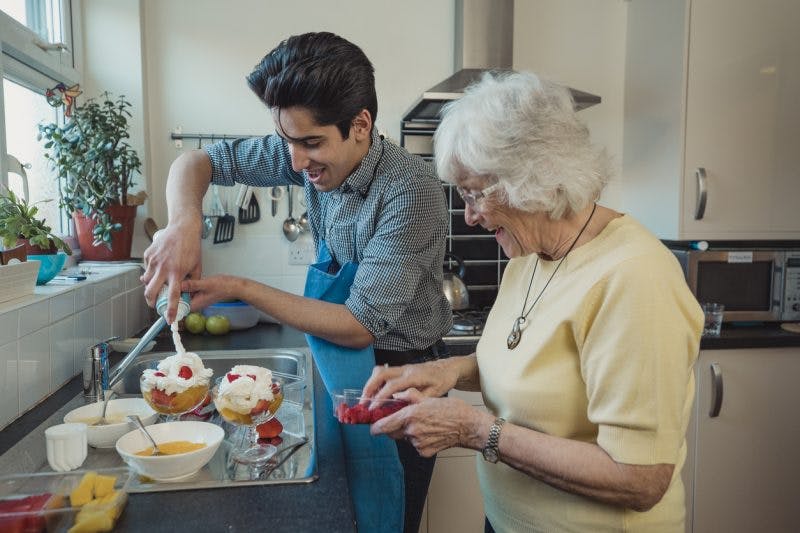A traumatic brain injury can drastically change one’s life. However, it is not only the survivor who is impacted by the effects of a TBI, but also their family members and other loved ones. When a brain injury survivor returns home, there are many ways that family members and loved ones can facilitate a smooth transition and provide a comfortable, supportive environment to promote recovery.
Living with someone with a brain injury can be challenging, but being an integral part of a survivor’s recovery process can also be very fulfilling. This article outlines some important recommendations for loved ones to consider to make living with someone with a brain injury a positive experience for all involved.
The links below can be used to jump directly to any section of this article.
- Effects of a traumatic brain injury
- Creating a safe home environment
- Fostering positive interactions
- Promoting recovery
Living with Someone with a Brain Injury
Following a traumatic brain injury, individuals may demonstrate a wide range of secondary effects. Depending on the severity and location of one’s brain injury, these effects may be minimal or significant, and can affect physical, cognitive, and/or emotional functions. Therefore, the experience of living with someone with a brain injury is always unique.
To better understand what living with someone with a brain injury could look like, here are a few of the most common effects of traumatic brain injury:
- Physical effects: weakness/paralysis, spasticity, walking/balance problems, headaches, swallowing difficulties, fatigue, sensory changes
- Cognitive effects: memory problems, communication changes, difficulties with attention/concentration, lack of insight, perseveration, executive dysfunction
- Emotional/Behavioral effects: depression, aggression, impulsivity, personality changes, flat affect, susceptibility to mental health conditions
With all of these potential effects (and more), it is impossible to develop a perfect guide for what to expect when living with someone with a brain injury. However, there are certain steps loved ones can take to help ease a survivor’s transition home, such as creating a safe environment, fostering positive interactions, and promoting recovery.
Creating a Safe Home Environment
Family members and loved ones should strive to create a safe home environment for survivors before they return home. Because brain injury may result in many physical impairments, vision changes, and poor judgment, it is essential ensure the survivor’s home is as safe as possible.
While occupational therapists are great resources to consult regarding home safety measures, some common recommendations include:
- Adding handrails to stairways and grab bars in the bathroom
- Removing rugs, cords, and clutter from walkways
- Keeping dangerous objects, such as knives, out of reach
- Using appropriate lighting, including nightlights
In addition to these safety measures, many survivors with cognitive deficits find that labelling cupboards and drawers, as well as providing checklists for commonly completed activities, can help promote independence. For example, some survivors may benefit from a checklist regarding how to safely heat up food in the microwave. While checklists and labels cannot ensure the survivor is navigating activities safely, they can be a step in the right direction.
Another excellent way to develop a safe environment is to create an area within the home that the survivor can retreat to if they begin to feel overstimulated. This can be an entire room or simply a calm, quiet area designed specifically for the survivor to use to rest and recuperate throughout their recovery.
Fostering Positive Interactions
While creating a safe environment is important, it is equally important to focus on fostering positive interactions when living with someone with a brain injury. Research has demonstrated that positive social supports can enhance recovery by helping to alleviate psychosocial factors related to brain injury, such as depression, anxiety, and mental fatigue.
As a brain injury can result in emotional, behavioral, and cognitive changes, family members and loved ones may find it more challenging to connect with the survivor. Additionally, the recovery process for any survivor may be emotionally draining, so intentionally interacting in a patient, understanding and supportive manner is essential.
The effects of brain injury are diverse and can be unpredictable, with some effects not becoming apparent until several months after the initial injury. While it may sometimes seem that survivors are intentionally being difficult, oftentimes negative behaviors can be attributed to their injury.
To promote calm, positive interactions, consider the following points:
- Remember the aftereffects of brain injury. Due to disinhibition and the psychological changes associated with brain injury, the survivor may not be in total control of their actions. However, it is still important for loved ones to set appropriate boundaries for their own physical health and emotional wellbeing.
- Use stress management strategies. Stress can have a significant impact on how individuals interact. Therefore, finding positive coping mechanisms to reduce stress, such as going for a walk outdoors or practicing mindfulness, can be an effective way to promote positive interactions.
- Join a support group. Participating in a brain injury support group can be a great way to learn how other survivors and their loved ones navigate the emotional challenges related to recovery.
- Encourage community reintegration. Adjusting to life after brain injury can be very difficult. Some survivors may find themselves becoming socially isolated. Getting out into the community can help to stimulate the brain, create positive experiences, and promote re-engagement. However, keep in mind that some survivors may easily become overstimulated, so consider starting out with quieter, more relaxed outings.
- Focus on the positives. While living with someone with a brain injury can be difficult at times, it is important keep a positive outlook. Focus on encouraging improvement and pointing out strengths while being a consistent source of support throughout the survivor’s recovery.
Fostering positive interactions can make the experience of living with someone with a brain injury more fulfilling. Although the recovery process after a traumatic brain injury may take time, focusing on making positive connections can help survivors and their families appreciate the journey.
Promoting Recovery
Individuals that are living with someone with a brain injury have the unique opportunity to be by the survivor’s side throughout the highs and lows of their recovery. Brain injury recovery is not linear; rather, survivors often experience times of progress, plateaus, and setbacks. However, family members and loved ones can play an essential role in helping survivors achieve an optimal recovery.
In order to best promote recovery, it is important to encourage survivors to pursue rehabilitation. Rehabilitative therapies, such as speech therapy, occupational therapy, physical therapy, and psychotherapy, focus on using repetitive exercises and activities to promote adaptive brain rewiring. This process is referred to as neuroplasticity.
When survivors consistently practice tasks involving affected functions, it signals to the brain that these functions are necessary. The brain then creates new neural pathways, allowing healthy areas of the brain to assume control of the affected functions. Outwardly, this process can be seen through functional improvements.
Therefore, when living with someone with a brain injury, it is important not only to encourage participation in rehabilitative therapies, but also to ensure that the survivor is continuing to practice using their affected functions in daily life. While it may seem easier to do tasks for the survivor, it is important for family members and loved ones to take a step back and allow survivors to try to do things for themselves.
Although practice is essential for recovery, there are times when it is appropriate to provide assistance. Finding the right balance between encouraging practice and helping out can be challenging, but being cognizant of the importance of functional practice and watching for signs of frustration can help.
Traumatic brain injury recovery does not occur overnight. Recovery requires consistent, intensive rehabilitation to promote adaptive changes within the brain. Through encouragement, advocacy, and support, loved ones can play a vital role in helping survivors achieve an optimal recovery.
Living with a TBI Survivor
Watching a survivor struggle with the effects of brain injury can be difficult. Fortunately, those living with someone with a brain injury have the unique ability to walk with the survivor as they navigate through the recovery process.
By taking steps to create a safe environment, foster positive interactions, and promote recovery, family members and loved ones can support survivors throughout their recovery journey. While it is impossible to understand what living with someone with a brain injury is like without having firsthand experience, these guidelines can help family members and loved ones feel prepared to provide the support that survivors need for recovery.










